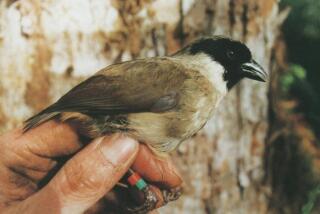Threat to Amphibians Rising
- Share via
Almost 150 species of amphibians apparently have become extinct and at least one-third of the rest are facing imminent threats that could soon wipe them out, according to a worldwide assessment by scientists published Thursday.
The severity of the global threat to thousands of species of frogs, salamanders and other amphibians makes them perhaps the most endangered class of animals, with their rapid decline outpacing that of mammals and birds.
David B. Wake of UC Berkeley’s Museum of Vertebrate Zoology, a leading amphibian expert, called the prospects for their survival “very grim.”
“These are simply stunning results,” Wake said of the report, published in the online version of the journal Science. “Nearly one-third of all the species are in the three top categories of endangerment, and nearly half the declines for unknown causes.”
For two decades, scientists have been trying to learn why amphibian populations are vanishing. Studies have documented threats varying from place to place, including infectious disease, destruction of freshwater and rain forest habitats, introduction of nonnative predators, pesticides, parasites, global climate change and the thinning ozone layer.
The findings of more than 500 scientists were included in the first global amphibian assessment, a three-year effort by researchers with IUCN -- a conservation group -- the Center for Applied Biodiversity Science of Conservation International and NatureServe.
Scientists say amphibians serve as sentinels for environmental problems that might be jeopardizing entire ecosystems of animals, even humans. They live mostly in water and breathe through their permeable skin, which leaves them vulnerable to pesticides and changes in climate and water quality.
“Amphibians are one of nature’s best indicators of overall environmental health,” said Russell A. Mittermeier, president of Conservation International. “Their catastrophic decline serves as a warning that we are in a period of significant environmental degradation.”
The report evaluated the status of all the 5,743 known species of amphibians and concluded that 1,856, or 32%, were critically endangered, endangered or vulnerable to extinction.
Too little is known about 1,300 others among the total to determine their status, but scientists believe that most of them also are in peril. That means that as many as 55% of all known species, more than 3,000, could be on the verge of extinction, plus scores that have yet to be identified. Only 359 are considered not threatened.
In the U.S., 21% of known species are threatened or extinct. California has more threatened amphibians than any other state, Conservation International says, with 13 of the nation’s 54. Many are in the higher Sierra Nevada, including Yosemite National Park.
“Amphibians are indeed telling us that our planet is being harmed right where you and I live,” said Andrew R. Blaustein, director of the graduate program in environmental sciences at Oregon State University.
Nine of 34 known extinctions have occurred since 1980 -- the onset of what is considered an age of accelerated, unnatural extinction driven by human activities. An additional 113 species have not been seen recently in the wild and are probably extinct, according to the report’s lead author, Simon Stuart. Evolutionary biologists say species disappear naturally at a much slower pace.
Amphibians have existed in their modern form for at least 150 million years, surviving the massive extinctions of the dinosaur age virtually unscathed.
“The fact that this tough survival group is checking out on our watch should concern us all,” said Wake, whose research focuses on the evolution and decline of salamanders.
“The fate of every species is extinction, but they have a chance to give rise to other species before they go extinct. These species are going extinct in a blink -- not even a blink in geological time.”
Scientists say the amphibians’ rate of extinction is so rapid that the report probably underestimates the numbers threatened. Perhaps hundreds of varieties of frogs and salamanders are being wiped out before they are even discovered, Wake said. For example, more than 90% of Sri Lanka’s rain forest is gone and the fragment that is left “is literally filled with undescribed species,” he said. “Who knows what we have lost?”
Similar evaluations of birds and mammals found smaller percentages at risk -- 23% for mammals and 12% for birds.
“We already knew amphibians were in trouble, but this assessment removes any doubt about the scale of the problem,” said Bruce Young, a zoologist with NatureServe in Costa Rica who was one of the authors of the report. “Now we need greater protection of natural areas and accelerated research on amphibian diseases to stem the extinction tide.”
* (BEGIN TEXT OF INFOBOX)
Species status
The worldÕs amphibians Ñ frogs, toads, salamanders and worm-like caecilians Ñ are facing unprecedented rates of extinction due to a variety of causes, from destruction of rain forests to infectious diseases and climate change.
Amphibians Species of least concern: 38.3% Insufficient data: 22.5% Endangered**: 13.3% Vulnerable**: 11.6% Critically endangered: 7.4% Not threatened: 6.3% Extinct or extinct in the wild*: 0.6%
Note: 5,743 known species *34 are extinct and one is extinct in the wild **Include 113 that are probably extinct
Source: Conservation International
More to Read
Sign up for Essential California
The most important California stories and recommendations in your inbox every morning.
You may occasionally receive promotional content from the Los Angeles Times.













